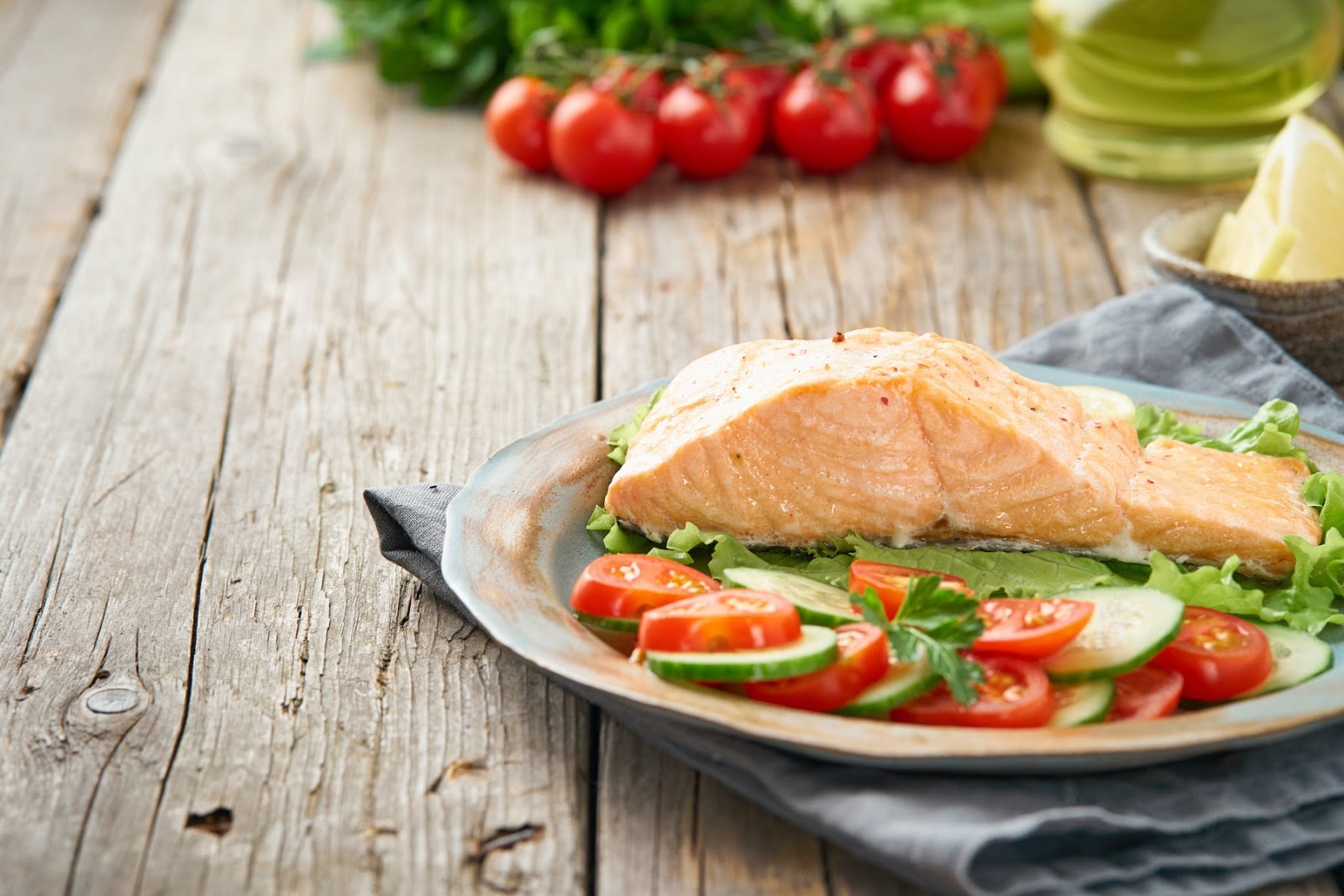A Step-By-Step Guide to the Low FODMAP Diet
A Low FODMAP Diet is One of the Best Ways to Heal the Gut—Here’s Why
- FODMAPs Defined|
- Food List|
- Science|
- When to Use Low FODMAP|
- Low FODMAP Diet|
- How to Use|
- Elimination|
- Reintroduction|
- Personalization|
- Bottom Line|
- Use a low FODMAP diet for IBS and other digestive symptoms if a basic Paleo diet hasn’t helped.
- Listen to your body closely to personalize your low FODMAP diet.
Research shows the low FODMAP elimination diet is one of the most effective diets for those with IBS symptoms like diarrhea, bloating, or gas. It can also improve energy and joint pain, and is one of the most common diets I recommend in the clinic. Let’s talk about what it is and how to use it.
What are FODMAPs?
FODMAPS are Fermentable Oligosaccharides, Disaccharides, Monosaccharides And Polyols, which are just fancy words for different types of fermentable starches and sugars.
FODMAP Food List
The most important tool for using the low FODMAP diet is a good FODMAP food list. Here is a summary of common low FODMAP foods and high FODMAP foods. You can download a more complete FODMAP food list here, including Paleo low FODMAP and vegetarian low FODMAP lists.
| Type | Low FODMAP Foods | High FODMAP Foods |
| Veggies | Zucchini, green beans, bok choy, red bell pepper, eggplant, carrot, lettuce, potato, tomato | Cauliflower, artichokes, asparagus, cabbage, broccoli, green bell pepper |
| Fruits | Blueberries, kiwi, banana, grape, lemon, lime, orange, cantaloupe | Blackberry, apricot, mango, apple, avocado, pear, peach, nectarines, watermelon |
| Legumes | x | Lentils, beans, chickpeas, peas |
| Nuts and Seeds | Macadamia nuts, almonds (<10), peanuts, pecans, walnuts (<10) | Cashews, pistachios, almonds (>10) |
| Dairy Products | Feta cheese, lactose-free milk or cheese, almond milk | Brie, ice cream, yogurt |
| Grains | White rice, quinoa, millet | Wheat and rye |
| Sweeteners | Glucose | Fructose, high fructose corn syrup, mannitol, xylitol, sorbitol, maltitol, agave |
| Prebiotics & Additives | x | Galactooligosaccharides (GOS), isomalt, inulin, fructooligosaccharides (FOS) |
Monash University has more detailed FODMAP food lists for the Reintroduction Phase.
There are two main reasons you may have trouble trouble digesting these short-chain carbohydrates:
- You may lack the right enzymes to digest them. An example would be lactose intolerance. If you lack the enzyme lactase, you may have trouble digesting lactose, the sugar in dairy products.
- You may have an overgrowth of gut bacteria in your large or small intestine that likes to feed on and ferment these sugars.
In either case, for some people, high FODMAP foods can aggravate IBS or Inflammatory Bowel Disease symptoms including:
- diarrhea or constipation
- gas
- bloating
- flatulence
- abdominal pain
They can even contribute to non-digestive symptoms like fatigue, brain fog, leaky gut, body pain, and mental health symptoms like anxiety.
By reducing the food for inflammatory bacteria, eating a low FODMAP diet reduces inflammatory cytokines, leaky gut, and gas pressure.
Though more research should certainly be done, this is promising evidence that the low FODMAP diet can improve symptoms and quality of life for people with digestive issues. My experience with patients in the clinic mirrors this research.
What Science Says About the Low FODMAP Diet
A low FODMAP diet reduces foods that can feed bacterial overgrowth. A systematic review and meta-analysis determined that the low FODMAP diet reduced overall digestive symptoms and abdominal pain, and increased quality of life. [1] A second meta-analysis came to a similar conclusion. [2]
Other research shows that the low FODMAP diet:
- Improves diarrhea in IBS-D [3]
- Improves IBS symptoms in patients with Inflammatory Bowel Syndrome (IBD) [4, 5, 6, 7]
- Positively impacts gut endocrine cells, which can normalize bowel function [8, 9, 10]
- Improves histamine levels [11] (although this has recently been challenged)
- Reduces digestive symptoms, such as bloating, abdominal pain, and gas [12, 13, 14, 15]
- Works better than standard dietary advice [16]
- Reduced pain for fibromyalgia patients [17]
When to Use a Low FODMAP Diet
As I discuss more fully in my book Healthy Gut, Healthy You, changing your diet to reduce inflammation is one of the most important first steps you can take to rehabilitate your digestive system.
The first place to start is with a basic elimination diet, like the Paleo diet. If you don’t see any improvement from the Paleo diet, the low FODMAP diet is the next diet to try, especially if you have:
- Irritable bowel syndrome (IBS)
- Inflammatory bowel disease (IBD), such as Crohn’s disease or ulcerative colitis
- SIBO or dysbiosis
- Leaky gut
- Fibromyalgia
Low FODMAP Diet Basics

The low FODMAP diet is an elimination diet low in high FODMAP foods. There are three main phases of the diet:
- Elimination Phase: During this phase, you avoid high FODMAP foods for 2-3 weeks. The goal of this phase is symptom relief.
- Reintroduction Phase: In the reintroduction phase, you test one high FODMAP food at a time. The goal in this phase is to identify which FODMAP foods most aggravate your symptoms.
- Personalization and Maintenance Phase: In this phase, you use what you’ve learned during the elimination and reintroduction phases to broaden your diet, but maintain your symptom remission.
How to Use the Low FODMAP Diet

Using the low FODMAP diet isn’t complicated, but it does require you to be methodical while you explore what will work for your body. Once you work through the process, you should have a much better idea of what foods your body does and doesn’t tolerate.
Elimination Phase
If you’ve already tried the Paleo diet, but didn’t get the relief you were hoping for, eliminating FODMAP foods is your next step. Do the initial elimination for 2-3 weeks. Use the FODMAP Food List (see above) to guide you.
It’s important to keep your eye on the true goal: to reduce the overall burden of FODMAP foods on your digestive system. You won’t be able to eliminate every single FODMAP food, and shouldn’t try to do so. Do the best you can, knowing that any reduction is likely to reduce your symptoms.
If you don’t notice any improvement during this phase, there’s no need to continue on the diet. (In this case, you may need to trial a more restrictive diet like the Autoimmune Paleo diet, or try a low FODMAP with the Specific Carbohydrate Diet restrictions.)
If your symptoms improve, this tells you that the low FODMAP diet is likely the right healing diet for you right now. However, do keep in mind that the elimination phase of the Low FODMAP diet isn’t meant to be a permanent diet.
After completing the elimination phase, move on to the reintroduction phase.
Reintroduction Phase
If you don’t react to a FODMAP food, there’s no reason to continue avoiding it. In the reintroduction phase, you will carefully reintroduce foods one at a time to expand your diet.
| FODMAP Reintroduction Step-By-Step | |
| 1 | Test one serving of a high FODMAP food. |
| 2 | Watch for a reaction. |
| 3 | If reaction occurs, continue to avoid that food. You can try again later. |
| 4 | If no reaction occurs, move on to the next food. |
| 5 | Continue testing FODMAP foods until you’re satisfied. Personalize your food list by testing individual foods to increase your food diversity. |
Begin by reintroducing the foods you miss most, one food at a time. If you don’t see a reaction, you can add that food back into your diet.
If you do experience a reaction, continue avoiding that food for now. As your digestive system heals, you will be able to tolerate more foods.
If you do have a reaction, make sure to wait until your reaction has subsided before you test the next food.
Sometimes, it can be helpful to think about which specific FODMAP starches you are reacting to. Here are some examples of foods that contain specific FODMAPs, but don’t overly focus on this level of detail. A complex diet becomes difficult to sustain.
| Type of FODMAP | Test Foods |
| Fructose | Sun-dried tomatoes, mango, artichoke hearts |
| Sorbitol | Avocado, yellow peach, green pepper |
| Fructans (FOS) | Leek, zucchini, garlic |
| Mannitol (Polyol) | Celery, cauliflower, sweet potato |
| Lactose | Plain yogurt, whole milk, cream |
| Galacto-oligosaccharide (GOS) | Canned black beans, green peas, almonds |
Personalization and Maintenance Phase
You can continue to reintroduce whichever foods you would like to personalize your low FODMAP diet. If you need help organizing your experiments, you can use a food journal to keep track.
If you’re feeling confused or need help, work with a knowledgeable dietitian, nutritionist, or health coach to keep a wide range of foods in your diet and to avoid nutrient deficiencies.
Key Tips for Using the Low FODMAP Diet
A few additional tips can help you succeed with the low FODMAP diet.
- Don’t stay on any diet too long if it’s not working. If you don’t notice any benefit after a few weeks, consider adapting your low FODMAP diet by adding the Specific Carbohydrate Diet (SCD) restrictions, or trialing the Autoimmune Paleo diet, as they remove more possible trigger foods.
- Trial potential trigger foods one at a time. If you have a reaction to a test food, wait until you have recovered to try the next one. Common reactions include an increase in digestive symptoms, like gas, bloating, diarrhea, or constipation. An increase in joint pain, brain fog, or mental health symptoms could also be possible.
- It’s ok to blend the low FODMAP template with another diet to match what your body needs. No one diet is right for everyone. Listen to your body.
The Bottom Line
The low FODMAP diet is a good bet if you have digestive symptoms like bloating or abdominal pain, but haven’t noticed symptom improvement from a basic Paleo diet. For the best results, follow the recommended steps to eliminate and reintroduce foods. Use the reintroduction period to create a customized diet that helps minimize your symptoms. But above all, listen to the feedback your body is giving you. If you are confused, get help from a professional.
Dr. Michael Ruscio is a DC, natural health provider, researcher, and clinician. He serves as an Adjunct Professor at the University of Bridgeport and has published numerous papers in scientific journals as well as the book Healthy Gut, Healthy You. He also founded the Ruscio Institute of Functional Health, where he helps patients with a wide range of GI conditions and serves as the Head of Research.➕ References
- Marsh A, Eslick EM, Eslick GD. Does a diet low in FODMAPs reduce symptoms associated with functional gastrointestinal disorders? A comprehensive systematic review and meta-analysis. Eur J Nutr. 2016;55(3):897-906. doi:10.1007/s00394-015-0922-1
- Altobelli E, Del Negro V, Angeletti PM, Latella G. Low-FODMAP Diet Improves Irritable Bowel Syndrome Symptoms: A Meta-Analysis. Nutrients. 2017;9(9):940. Published 2017 Aug 26. doi:10.3390/nu9090940
- Zahedi MJ, Behrouz V, Azimi M. Low fermentable oligo-di-mono-saccharides and polyols diet versus general dietary advice in patients with diarrhea-predominant irritable bowel syndrome: A randomized controlled trial. J Gastroenterol Hepatol. 2018;33(6):1192-1199. doi:10.1111/jgh.14051
- Gibson PR. Use of the low-FODMAP diet in inflammatory bowel disease. J Gastroenterol Hepatol. 2017;32 Suppl 1:40-42. doi:10.1111/jgh.13695
- Pedersen N, Ankersen DV, Felding M, et al. Low-FODMAP diet reduces irritable bowel symptoms in patients with inflammatory bowel disease. World J Gastroenterol. 2017;23(18):3356-3366. doi:10.3748/wjg.v23.i18.3356
- Zhan YL, Zhan YA, Dai SX. Is a low FODMAP diet beneficial for patients with inflammatory bowel disease? A meta-analysis and systematic review. Clin Nutr. 2018;37(1):123-129. doi:10.1016/j.clnu.2017.05.019
- Cox SR, Lindsay JO, Fromentin S, et al. Effects of Low FODMAP Diet on Symptoms, Fecal Microbiome, and Markers of Inflammation in Patients With Quiescent Inflammatory Bowel Disease in a Randomized Trial. Gastroenterology. 2020;158(1):176-188.e7. doi:10.1053/j.gastro.2019.09.024
- Mazzawi T, El-Salhy M. Changes in duodenal enteroendocrine cells in patients with irritable bowel syndrome following dietary guidance. Exp Biol Med (Maywood). 2017;242(13):1355-1362. doi:10.1177/1535370217699537
- Mazzawi T, Hausken T, Gundersen D, El-Salhy M. Dietary guidance normalizes large intestinal endocrine cell densities in patients with irritable bowel syndrome. Eur J Clin Nutr. 2016;70(2):175-181. doi:10.1038/ejcn.2015.191
- Mazzawi T, El-Salhy M. Effect of diet and individual dietary guidance on gastrointestinal endocrine cells in patients with irritable bowel syndrome (Review). Int J Mol Med. 2017;40(4):943-952. doi:10.3892/ijmm.2017.3096
- McIntosh K, Reed DE, Schneider T, et al. FODMAPs alter symptoms and the metabolome of patients with IBS: a randomised controlled trial [published correction appears in Gut. 2019 Jul;68(7):1342]. Gut. 2017;66(7):1241-1251. doi:10.1136/gutjnl-2015-311339
- Gibson PR, Shepherd SJ. Evidence-based dietary management of functional gastrointestinal symptoms: The FODMAP approach. J Gastroenterol Hepatol. 2010;25(2):252-258. doi:10.1111/j.1440-1746.2009.06149.x
- Gibson PR, Shepherd SJ. Food choice as a key management strategy for functional gastrointestinal symptoms. Am J Gastroenterol. 2012;107(5):657-667. doi:10.1038/ajg.2012.49
- Gibson PR, Shepherd SJ. Evidence-based dietary management of functional gastrointestinal symptoms: The FODMAP approach. J Gastroenterol Hepatol. 2010;25(2):252-258. doi:10.1111/j.1440-1746.2009.06149.x
- Gibson PR, Shepherd SJ. Food choice as a key management strategy for functional gastrointestinal symptoms. Am J Gastroenterol. 2012;107(5):657-667. doi:10.1038/ajg.2012.49
- Zahedi MJ, Behrouz V, Azimi M. Low fermentable oligo-di-mono-saccharides and polyols diet versus general dietary advice in patients with diarrhea-predominant irritable bowel syndrome: A randomized controlled trial. J Gastroenterol Hepatol. 2018;33(6):1192-1199. doi:10.1111/jgh.14051
- Marum AP, Moreira C, Saraiva F, Tomas-Carus P, Sousa-Guerreiro C. A low fermentable oligo-di-mono saccharides and polyols (FODMAP) diet reduced pain and improved daily life in fibromyalgia patients. Scand J Pain. 2016;13:166-172. doi:10.1016/j.sjpain.2016.07.004

Discussion
I care about answering your questions and sharing my knowledge with you. Leave a comment or connect with me on social media asking any health question you may have and I just might incorporate it into our next listener questions podcast episode just for you!